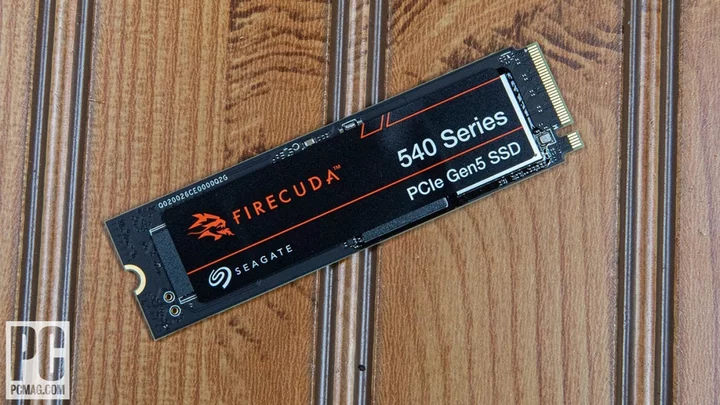The Seagate FireCuda 540 (starts at $179.99 for 1TB; $299.99 for 2TB as tested) isn't the absolute, tip-top fastest PCI Express 5.0 solid-state drive (SSD) we've tested. That honor belongs to our top pick in the category, the Crucial T700. But the FireCuda 540 still stands out with a higher durability (TBW) rating than competing Gen 5 drives, which could be an advantage if you plan on writing and overwriting large amounts of data to the drive. It also achieved a new high score in our 3DMark Storage gaming-oriented benchmark, which is especially sweet since Seagate's FireCuda line is targeted specifically to gamers. It's a game of minute differences among these emerging drives, but the FireCuda 540 is a solid choice among this elite set so far.
Anatomy of a Gen 5 Speedster
The FireCuda 540 is a four-lane PCI Express 5.0 drive manufactured on an M.2 Type-2280 (80mm) "gumstick" PCB. This two-sided internal SSD employs the NVMe 2.0 protocol over the PCI Express 5.0 bus. The FireCuda uses Micron's 232-layer TLC NAND flash, as well as Phison's latest PS5026-E26 controller, which is optimized for PCIe 5.0 SSDs, although it is also backward-compatible with PCI Express 4.0 and even 3.0 drives. (Check out our glossary of SSD terms if you are baffled by some of this lingo.)
Available in 1TB and 2TB capacities, the 540 ships without a heatsink. At the speeds this and other Gen 5 drives are capable of, an effective heat dissipation solution is necessary. You will need to use the heatsink included with your motherboard over the PCI Express 5.0-capable M.2 slot, or otherwise an aftermarket heavy-duty cooling solution.
To fully support the FireCuda 540 or a similar PCIe 5.0 SSD, you must either buy one of the few Gen 5-compatible boutique desktops or build your own with a brand-new CPU and motherboard (we will go into detail below on the system requirements). The 540 is backward-compatible with PCI Express versions 4.0 and even 3.0, but will revert to the maximum throughput of those older interfaces, which defeats the purpose (and expense) of buying a Gen 5 drive in the first place.
(Credit: Molly Flores)The 2TB version of the 540 that we tested is rated at up to 10,000MBps for both sequential read and write speeds; the 1TB model has a rated read speed of up to 9,500MBps, and a 8,500MBps rated write speed. This is similar to several other PCI Express 5.0 SSDs we have tested. The Corsair MP700 Gen5 M.2 SSD has the same rated speeds for both its 1TB and 2TB models, as does the Gigabyte Aorus 10000 Gen5 SSD, except that the Aorus 10000 2TB model's write-speed rating is a little lower (9,500MBps).
In terms of raw speed, none of these drives can keep up with the Crucial T700, whose 2TB and 4TB models are rated at up to 12,400MBps for read speed and 11,800MBps for read speed, with ratings of 11,700MBps read and 9,500MBps write for its 1TB model. Still-faster Gen 5 SSDs are on tap, like the MSI Spatium M570 Pro—with a maximum 14,000MBps sequential read speed (matching the PCI Express 5.0 theoretical limit)—which we recently saw demoed at Computex.
As for durability, expressed in terms of lifetime write capacity in total terabytes written (TBW), the FireCuda 540 rules the roost among the Gen 5 drives we have tested. The Aorus 10000 is rated at 700TBW for its 1TB stick and 1,400TBW for 2TB, and the Crucial T700 is rated at 600TBW and 1,200TBW for 1TB and 2TB respectively.
A few PCI Express 4.0 drives offer substantially higher durability ratings; the MSI Spatium M470, for example, is rated at 1,600TBW for 1TB and 3,300TBW for 2TB. At the other extreme, the Mushkin Delta, which uses less-durable QLC memory, is rated at just 200TBW for 1TB, 400TBW for 2TB, and 800TBW for 4TB.
(Credit: Molly Flores)The terabytes-written spec is a manufacturer's estimate of how much data can be written to a drive before some cells begin to fail and get taken out of service. Seagate warranties the FireCuda 540 for five years or until you hit the rated TBW figure in data writes, whichever comes first. But the drive's durability rating is such that unless you're writing huge amounts of data to the SSD, it's a safe bet that the 540 will last the full warranty period. Seagate also provides three years of Rescue Data Recovery Services coverage against unexpected data loss for any mechanical, accidental, or natural disaster, which includes one in-lab data recovery attempt.
Testing the FireCuda 540: A New Gaming Benchmark Champ
This new generation of SSDs promises a speed boost, but you'll only be able to enjoy it if your hardware is new enough to support the PCIe 5.0 standard. Only the latest high-end desktops are likely to support PCI Express 5.0 off the shelf, so you may have to build your own PC from scratch or perform a major update on an existing desktop. Intel users will need a 12th or 13th Generation Core CPU with a motherboard based on Intel's Z690 or Z790 chipset. AMD fans must have a Ryzen 7000 series processor and an AM5 motherboard with an X670, X670E, or B650E chipset. Important: You'll also have to be sure the board actually has a PCI Express 5.0 M.2 slot implemented. The chipset is not a guarantee, just an indication that the motherboard maker could include one; some of these boards will have only PCI Express 5.0 x16 expansion card slots, and not compliant M.2 SSD slots.
In benchmarking the FireCuda 540, we used our latest storage testbed desktop, designed specifically for testing PCIe 5.0 M.2 SSDs. It consists of an ASRock X670E Taichi motherboard with an AMD X670 chipset, 32GB of DDR5 memory (two Crucial 16GB DIMMs), one PCIe 5.0 x4 M.2 slot (with lanes that have direct access to the CPU), and three PCIe 4.0 slots. It sports an AMD Ryzen 9 7900 CPU using an AMD stock cooler and an Nvidia GeForce RTX 2070 Super card with 8GB of GDDR6 SDRAM; and it is powered by a Thermaltake Toughpower GF1 Snow 750W PSU. The boot drive is an ADATA Legend 850 PCIe 4.0 SSD. All this is housed in a Praxis Wetbench open-frame case.
(Credit: Molly Flores)We put the Seagate FireCuda 540 through our usual slate of internal solid-state drive benchmarks, comprising Crystal DiskMark 6.0, PCMark 10 Storage, and UL's 3DMark Storage Benchmark, which measures a drive's performance in a number of gaming-related tasks.
Crystal DiskMark's sequential speed tests provide a traditional measure of drive throughput, simulating best-case, straight-line transfers of large files.
The FireCuda 540 slightly exceeded its rated read and write speeds, in both cases topping the 10,000MBps milestone. Both the Aorus 10000 and Corsair MP700 had similar read- and write-speed results, while the Crucial T700 turned in speeds in line with its somewhat higher ratings. The 540's speeds were far in excess of even the fastest of our PC Express 4.0 comparison SSDs, exceeding the closest read speed—tallied by the ADATA Legend 960—by more than 33%, and the nearest write speed—chalked up by the SK Hynix Platinum P41—by a whopping 47%.
As impressive as the blistering raw speed of the FireCuda 540 and other PCI Express 5.0 drives is, it's of little use if your SSD can't quickly perform the tasks you need it for. The PCMark 10 Overall Storage test measures a drive's speed in a variety of routine tasks such as launching Windows, loading games and creative apps, and copying both small and large files.
The FireCuda's PCMark Storage Overall score was in line with the Gen 5 SSDs with similar rated speeds that we have tested, slightly (3.6%) below the Crucial T700, and 7.5% faster than the nearest PCI Express 4.0 SSD in our comparison group, once again the SK Hynix P41.
As for PCMark 10's subtests or individual traces, the FireCuda 540, like the other three Gen 5 SSDs, produced middling results compared with our PCIe 4.0 drives. Where the PCI Express 5.0 SSDs really shone, and what clinched their wins in the PCMark 10 Overall results were the copy test traces. Like its peers, the FireCuda 540 posted scores more than 20% higher than the best PCIe 4.0 drive in the ISO (large-file) copy trace and nearly 60% higher in the trace for smaller files.
Finally, the FireCuda 540 earns bragging rights with a new high score on the 3DMark Storage test, which assesses an SSD's aptitude in a set of gaming-related tasks. It bested its nearest rival, the Crucial T700, by 2%—a modest margin, sure, but a win by a nose is still a win.
Verdict: This Is One Seaworthy SSD
Befitting an SSD in the FireCuda line, the Seagate FireCuda 540 made a splash in our 3DMark Storage gaming-oriented testing, eking out a win over the Editors' Choice-winning Crucial T700. That said, despite clearing the 10,000MBps mark in both sequential read and write speeds, the 540 is not the fastest SSD on the block. That honor goes to the T700, and even faster PCI Express 5.0 drives are on the way. The 540 does stand out for having the highest durability rating of the Gen 5 SSDs we have reviewed, which could be a factor if you write scads of data to the drive.
(Credit: Molly Flores)In addition to having much higher raw speed, the Crucial T700 turned in slightly better results in our PCMark Storage Overall and trace testing, and it remains our Editors' Choice pick. But the FireCuda 540 did bare its razor teeth in our 3DMark Storage benchmarking, and it joins a long line of top-notch FireCuda SSDs geared to give you an advantage in your struggle for gaming dominance. Just be prepared to seriously mod your rig, or—more likely—to buy or build a new PC with the cutting-edge hardware to support it.









